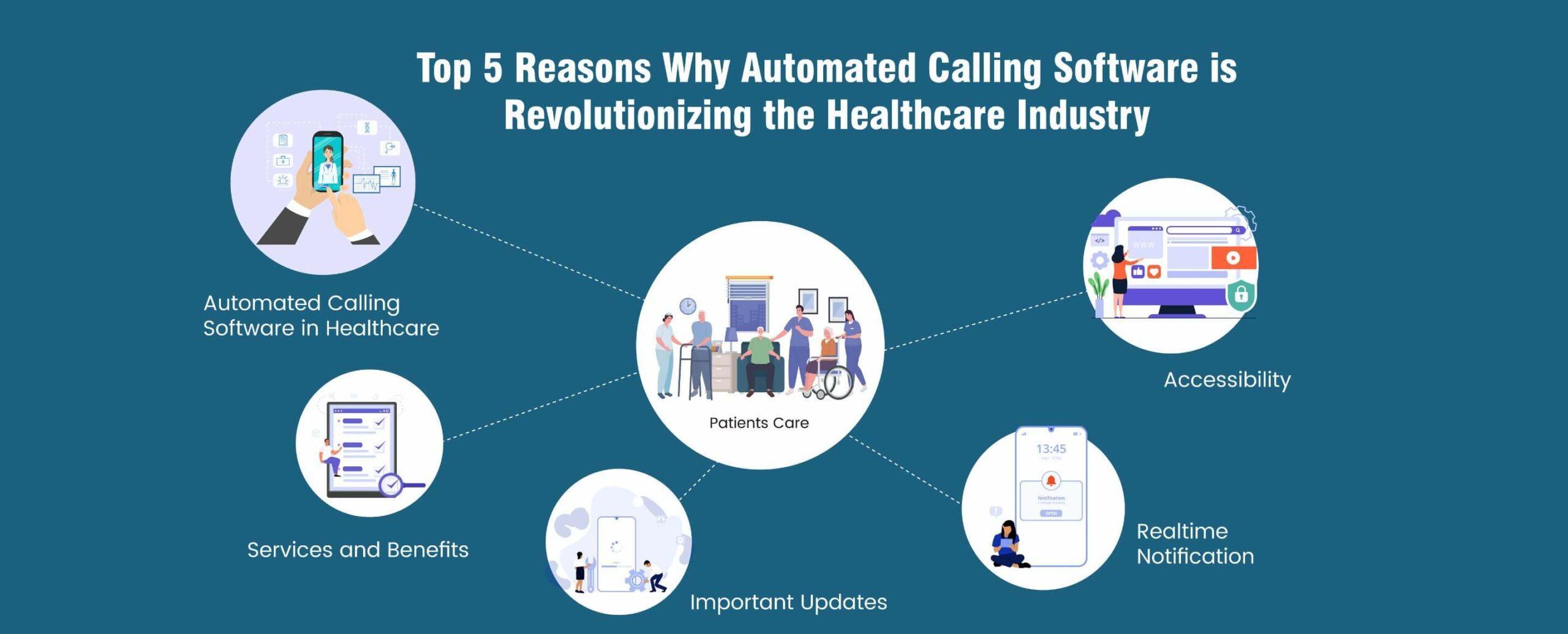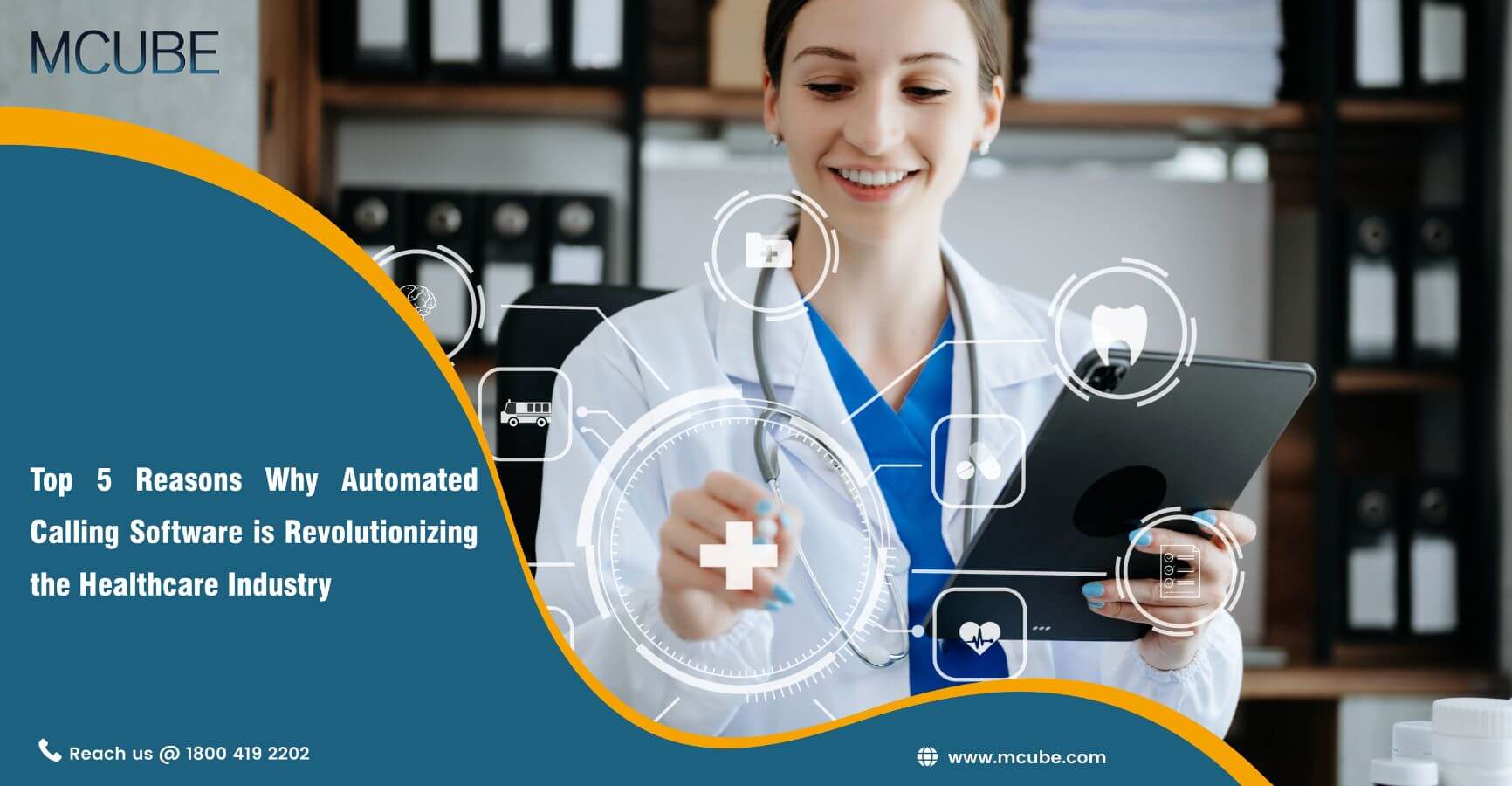The healthcare industry relies on efficiency and clear communication. However, managing patient communication can be tough for busy medical practices. Long hold times, missed reminders, and a high call volume can strain staff and patients. Automated calling software, like autodialers or automated dialing systems, helps here.
This software uses pre-recorded messages and IVR systems to streamline patient communication. It offers several benefits that can improve the patient experience and boost efficiency in healthcare practices.
What is Automated Calling Software?
Automated calling software streamlines communication by automatically dialing phone numbers from a predefined list. It efficiently delivers pre-recorded messages, allowing for seamless interaction with patients.
Through interactive voice response (IVR) systems, it collects responses from recipients, enabling tailored communication. Additionally, the software facilitates direct connection to live agents for further assistance, enhancing customer service.
Why is it Ideal for Healthcare?
The fast paced environment of healthcare demands efficient communication. Here’s how automated calling software addresses this need:

1) Improved Efficiency and Increased Productivity:
a) Decreased Human Burden: Day-to-day duties such as scheduling reminders, conveying test outcomes, and issuing medication refills can be automated, liberating staff to engage in more intricate patient engagements.
b) Enhanced Operational Efficiency: Implementing automated protocols for standard calls enables healthcare establishments to manage increased communication loads seamlessly, thus reducing wait durations and optimizing workflow effectiveness.
c) 24/7 Accessibility: Automated calls transcend standard business hours, guaranteeing patients receive prompt updates at any time of day.
d) Appointment Alerts: Predetermined automated calls act as gentle reminders for upcoming appointments, minimizing the likelihood of missed appointments and optimizing time management.
e) Lab Result Updates: Patients are notified via automated messages about fundamental laboratory results, reducing the need for unnecessary communication with healthcare providers.
f) Medication Renewal Alerts: Automated systems prompt patients to renew prescriptions, averting potential health risks from medication shortages.
g) Campaign Outreach: Utilize automated calls for disseminating public health advisories or promoting upcoming health events, efficiently reaching a broad audience.
2) Enhanced Patient Engagement and Care:
a) Enhanced Appointment Administration: Automated reminders significantly decrease missed appointments, addressing a key issue in healthcare. This results in better resource utilization and improved continuity of patient care.
b) Initiating Patient Interaction: Automated calls prove beneficial for proactive healthcare measures like preventive care, medication adherence reminders, and managing chronic conditions, resulting in enhanced patient results.
c) Elevated Patient Satisfaction: Prompt communication and easily accessible information contribute to a more positive patient experience. It can serve as a potent tool for boosting patient engagement. For instance:
d) Post-Appointment Follow-ups: Automated calls can be utilized to check in with patients after appointments, ensuring they grasp treatment plans and medication instructions.
e) Patient Feedback Collection: Automated systems facilitate the gathering of patient opinions and health survey data, offering valuable insights for enhancing healthcare services.
f) Health Maintenance Notifications: It privately quick individuals to stay current with health check-ups or vaccination schedules, encouraging a proactive view on wellness.
3) Cost-Effectiveness and Increased Revenue:
a) Efficiency in Administrative Tasks: Automating calls minimizes the need for staff involvement in repetitive duties, resulting in notable cost reductions.
b) Optimized Revenue Management: Automated reminders for outstanding balances can boost the effectiveness of payment collection processes.
c) Targeted Marketing Initiatives: Software encourages focused outreach campaigns to introduce new services or educate patients on preventive healthcare.
4) Increased Accuracy and Less Errors:
a) Data Integration: Integration with healthcare IT systems allows for personalized messages based on patient data, reducing the need for manual information verification.
b) Improved Reporting: Automated calling software provides detailed reports on call logs and patient interactions, allowing for data-driven decision-making and process improvement.
c) Automated Scheduling Reminders: Patients can receive calls with options to confirm or reschedule appointments, reducing the back-and-forth communication with staff.
d) Open Appointment Notification: If a cancellation opens up an appointment slot, the system can automatically contact patients on the waitlist, filling gaps in the schedule more efficiently.
e) Two-way SMS Integration: Automated systems can integrate with SMS messaging, allowing patients to confirm appointments or reschedule via text message, offering a convenient option for busy patients.
5) Enhanced Accessibility and Inclusivity:
a) Multilingual Support: Messages in multiple languages ensure effective communication with diverse patient groups.
b) Accessibility for All: Integration with text-to-speech tech or SMS options cater to hearing-impaired patients.
c) Better Remote Communication: It can reach patients in remote areas, improving access to healthcare.
d) Community Health Promotion: Calls inform the public about free health screenings and mental health hotlines.
Also,
e) Vaccine Reminders: Automated calls can remind individuals about upcoming flu shot clinics or other vaccination opportunities, promoting preventative healthcare.
f) Disease Outbreaks: Public health agencies can use automated calls to disseminate vital information about outbreaks and steps to prevent the spread of disease.
By utilizing automated calling software, public health agencies can ensure critical information reaches the public in a timely and effective manner.
Things to Consider Before Implementing Automated Calling Software:
While automated calling software offers numerous benefits, it’s crucial to implement it strategically:
a) Compliance with Regulations: Ensure the software adheres to telemarketing regulations like the Telephone Consumer Protection Act (TCPA) and state-specific Do Not Call (DNC) lists.
b) Patient Preferences: Offer an opt-out option for patients who prefer to receive communication through other channels.
c) Data Security: Choose a software provider with robust data security measures to protect sensitive patient information.
Finding the Right Automated Dialer:
Autodialers are a powerful tool for sales and outreach, but with so many options, choosing the best automated dialer one can be overwhelming. Look for features that align with your needs. Do you prioritize dialing speed and lead volume (predictive dialer) or personalized conversations (progressive dialer)? Consider integrations with your CRM for seamless data flow. Top choices offer features like call recording, analytics, and omnichannel communication (combining voice and email). Research user reviews and pricing to find the best automated dialer for your business need that dials up success for your team!
Conclusion
The healthcare sector is encountering significant changes through the utilization of automated calling software. This technology allows medical professionals and facilities to increase efficiency and reduce costs, all while improving patient care.
Automated calling software facilitates redundant tasks such as appointment reminders and test result notifications, freeing up staff for more critical duties. Patients benefit from 24/7 access to information and timely reminders, reducing missed appointments and improving prevailing care. Additionally, this software aids in medication refills and preventive care initiatives.
Cost-effectiveness is a key advantage, as the software saves staff time and improves revenue collection. Its integration with other healthcare systems assures accuracy. Furthermore, the software’s multilingual abilities and reach to remote areas improve accessibility and inclusivity.
Healthcare providers must have regulations, provide opt-out options for patients, and prioritize security measures to protect patient privacy when implementing this technology.


